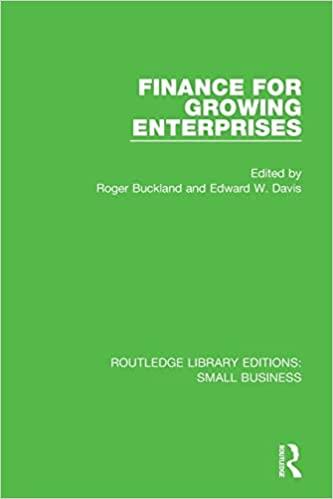Question
Lets Play . . . Cash for Questions! Imagine that you are a contestant on a popular television quiz show, Cash for Questions. You are
Lets Play . . . Cash for Questions!
Imagine that you are a contestant on a popular television quiz show, Cash for Questions. You are thrilled that the category is Corporate Cost of Capital, because you just learned about the concepts and calculations used in the management of a firms inventory in your corporate finance class.
There are five questions in this category, and the host, Caleb Cash, will give you the answer to each question in each of the following boxes. Remember, you must phrase your response in the form of a question and type in the correct entry. Good luck!
Question 1: $100
-This system can take the form of a red-line method in its simple form or an incredibly sophisticated computerized method, and it usually varies with the size of the firm and the nature of the goods being managed.
A. The Two Bin Inventory System
B. Total ordering costs
C. The inventory Control
D. The seasonal demand
E. Stock-out costs
Question 2: $200
-This method of accounting for inventory bases the value of a firms cost of goods sold on the newest inventory items and the value of the remaining (ending) inventory on the goods purchased least recently.
A. Total ordering costs
B. The Two Bin Inventory System
C. The last in, first-out inventory method
D. Stock-out costs
E. The seasonal Demand
Question 3: $300
-Everything else being equal and in the absence of a safety stock, when orders are placed for quantities less than those indicated using the Economic Ordering Quantity model, these costs will be the greater of the two major inventory costs.
A. Ordering costs
B. The Safety Stock
C. The quantity discount'
D. Stock Out costs
E. Total ordering costs
Question 4: $400
-The costs associated with warehousing a firms raw-materials, work-in-progress, and finished-goods inventories and the associated insurance and obsolescence costs are examples of this major type of inventory cost.
A. Stock Out costs
B. Carrying Costs
C. Ordering costs
D. Total Inventory Costs
E. The Just in time inventory
Question 5: $500
-A firm holds this type of inventory to satisfy a greater-than-average or greater-than-expected consumer demand or to protect against delays in receiving orders.
A. The Just in time inventory
B. The Safety Stock
C. The inventory Control
D. Carrying costs
You are now in the final round of the game. This is the Show-Off Round. Given three statements or phrases, identify the question that the statements answer.
Identifying the correct question will earn you $1,000.
Show-Off Round: $1,000
-Sales can be forecasted perfectly.
-Sales are evenly distributed throughout the year.
-Orders are received when expected.
A. What are three assumptions of the cash-transfer model?
B. What are three factors that affect an items annual or seasonal demand?
C. What are three assumptions of the Economic Ordering Quantity model?
Step by Step Solution
There are 3 Steps involved in it
Step: 1

Get Instant Access to Expert-Tailored Solutions
See step-by-step solutions with expert insights and AI powered tools for academic success
Step: 2

Step: 3

Ace Your Homework with AI
Get the answers you need in no time with our AI-driven, step-by-step assistance
Get Started


